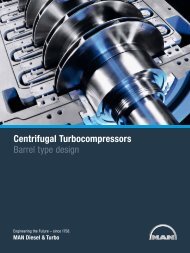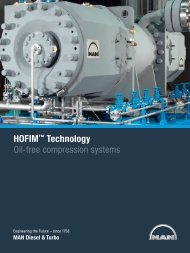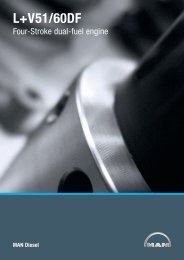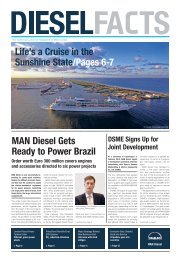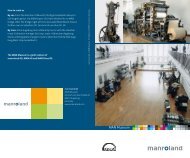Service Experience - MAN Diesel & Turbo - 首页
Service Experience - MAN Diesel & Turbo - 首页
Service Experience - MAN Diesel & Turbo - 首页
Create successful ePaper yourself
Turn your PDF publications into a flip-book with our unique Google optimized e-Paper software.
60,000<br />
50,000<br />
40,000<br />
30,000<br />
20,000<br />
10,000<br />
0<br />
1982 - 2000 2001 2002 2003 2004 2005 2006 2007 2008 2009<br />
Fig. 47: Main bearing population 1982-2009 divided into bearing types<br />
80<br />
70<br />
60<br />
50<br />
40<br />
30<br />
20<br />
10<br />
0<br />
Thick<br />
Thin/WM small bore<br />
Thin/WM large bore<br />
Thin/ AISn40<br />
Alignment<br />
procedure finalised<br />
New SL –<br />
Reduced t op clearances<br />
Flex-edge introduced<br />
Fig. 48: Thick shell main bearing damage statistics<br />
crankshaft. An example is shown in Fig.<br />
49. In this case, the reason for the damage<br />
was incorrect assembly after an<br />
24 <strong>Service</strong> <strong>Experience</strong> of <strong>MAN</strong> B&W Low Speed <strong>Diesel</strong> Engines<br />
Total main bearing population<br />
in service divided types/designs<br />
Graphic presentation of the positive<br />
influence by the OLS type main<br />
bearing, reduced top clearance and<br />
off -set / alignment procedure updates.<br />
Aft<br />
Centre<br />
Fore<br />
Three aft - most main bearings<br />
Remaining main bearings<br />
Main bearings Nos. 1 & 2<br />
Revised top (reduced)<br />
clearance range introduced<br />
1999 2000 2001 2002 2003 2004 2005 2006 2007 2008 2009<br />
open-up inspection of a main bearing<br />
after sea trial.<br />
This sequence of events following openup<br />
inspections of bearings is unfortunately<br />
being reported from time to time.<br />
We have therefore changed our instruction<br />
material, not calling for open-up inspection<br />
at regular intervals. In parallel,<br />
we have made so-called bearing wear<br />
monitoring (BWM) systems the standard<br />
on newly ordered engines. BWM<br />
systems can also be retrofitted on existing<br />
engines.<br />
In principle, the BWM system monitors<br />
all major bearings (main, crankpin and<br />
crosshead) by measuring the distance<br />
to the bottom dead centre of the crosshead,<br />
see Fig. 50. The distance will<br />
decrease if wear occurs in one of the<br />
major bearings, and the BWM system<br />
can then give an alarm.<br />
By monitoring wear in the major bear-<br />
ings, condition based monitoring (CBO)<br />
of bearings is introduced, and regular<br />
open-up inspections can be limited to<br />
fewer than previously. Optimally, openup<br />
inspections should, if at all needed,<br />
only be carried out during dry-dockings<br />
or when indications (bearing metal in<br />
bedplate or BWM alarm) call for it.<br />
This revised strategy will further limit the<br />
cases of severe bearing breakdowns.<br />
Also water in oil (WIO) monitoring sys-<br />
tems have been added to the stand-<br />
ard instrumentation for newly ordered<br />
engines. This is especially important in<br />
relation to crosshead bearings with lead<br />
overlayer being sensitive towards corrosion<br />
due to a too high water content in<br />
the system oil.



